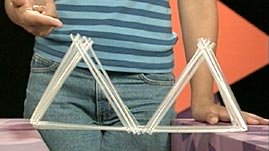The simplest of all bridges is called a beam bridge. This type of bridge is made up of beams that extend from one side of a gap to the other. Beams are anchored to solid ground at each end and carry the entire weight of the bridge deck and its loads. Because of this, long spans require very stiff and strong beams. The longer the span, the stronger and more rigid a beam needs to be to counteract the downward force it will experience.
Increasing the mass of the beams increases rigidity and strength, but it also adds weight to the structure. However, supports called trusses can stiffen horizontal beams without greatly increasing weight. Trusses are made up of a series of triangles linked together. Engineers use triangles as opposed to other shapes because triangles are inherently strong. Unlike a rectangle, for example, a triangle cannot be deformed without changing the length of one of its sides or breaking one of its joints. When joined together, a series of alternating upright and upside-down triangles creates a rigid and lightweight beam.
In this video segment, the
ZOOM cast attempts to construct a bridge made of drinking straws that will hold 200 pennies. When their first attempt fails, they make two changes to the bridge: They widen the deck and add triangular supports. Either design change would probably have been sufficient to meet their objective. However, the triangular supports, especially if each triangle shared a side of the one next to it, would likely have been the lighter and cheaper solution to a similar problem in the real world.


 Loading Standards
Loading Standards Teachers' Domain is proud to be a Pathways portal to the National Science Digital Library.
Teachers' Domain is proud to be a Pathways portal to the National Science Digital Library.
